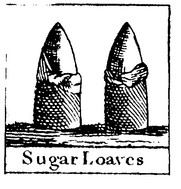HSP HISTORY Blog |
Interesting Frederick, Maryland tidbits and musings .
|
 Quartzite Quartzite Well it sure sounds pretty ominous, but let me assure you that our monadnock is sweet and lovable—actually “sugary sweet,” at least in name. And we certainly aren’t talking about a creature like Sasquatch, Chupacabra or even the Snallygaster. What we have is a geologic phenomenon, and not one of biological creation. To start the conversation, I want to point out that we have rocks in our area that were formed in the early Paleozoic period of the Cambrian era. This was roughly 500 million years ago and the result is a rock called Weverton Quartzite. Quartzite was originally pure quartz sandstone before the conversion process of metamorphosis which consisted of heating and pressure related by techtonic compression. Put more simply, this is the compacted form of sand, perhaps coming from the shoreline of ancient beaches first turned into sandstone and later into quartzite. The mountains of Frederick County were formed at a time when most of our vicinity was underwater. The uplifting could have been caused by the collision of plates such as ours with Africa. Our mountains, when they were “brand, spanking new,” are said to have been as high as the Himalayas, and multiple times higher than younger chains such as the Rockies. Our ancient Catoctin Mountain (and South Mountain) wore down over the next couple of million years thanks to erosive factors.  "Sunset Sugarloaf Mountain, Dickerson, MD" by artist Mimi Betz "Sunset Sugarloaf Mountain, Dickerson, MD" by artist Mimi Betz The most unique of our vicinity’s landforms, the picturesque Sugarloaf Mountain, is really not a mountain in the general sense. Rather it is better known as a monadnock. And what’s a monadnock you ask? A monadnock is a unique geologic creation of a landform resembling a mountain that remains after erosion of surrounding land, but not uplifting of the earth’s crust. These are isolated mountains in a general sense. Created the same time as the Blue Ridge mountains, geologists conclude that Sugarloaf Mountain represents the original elevation of the area around it, and took approximately 14 million years to form. This can be blamed in part on the quartzite cap at the summit which as highly resistant to erosional factors as opposed to the surrounding underlying limestone of Carrollton Manor. Just imagine the analogy of holding an umbrella over yourself during a downpour of rain. Everything around you gets soaked, but not you.  It is thought that the early French-Canadian fur traders named the mountain at the turn of the 17th century. The landform resembled the way blocks of sugar, in conical form, were being sold in Europe and also packed for sea voyage. They consisted of the top representing the clumped sugar peeking out from a green or brown paper wrapper. Two of our area’s first European explorers were Franz Ludwig Michel and Baron Christoph Von Graffenried. Both were from Switzerland and had the opportunity to climb the monadnock in the first decade of the 1700’s. In his diary, Graffenried claims that the traders call the mountain “pain du sucre.” He likely learned this from his guide up the mountain, a reknown French Canadian fur trader named Martin Chartier. Chartier was married to a Shawnee woman, had a large contingent of Shawnee followers and operated a trading post at the mouth of the Monocacy around 1712-13. Just for trivial effect, I will share that one of the most famous monadnocks in America is Pilot Mountain, located in Surrey County, North Carolina. It is located near Mt. Airy, the real hometown of television legend Andy Griffith. Now for the Andy Griffith television show of the 1960’S, Sherriff Andy Taylor lived in Mayberry (a play on Mt. Airy). The neighboring town (on the show) was Mount Pilot, which takes its inspiration from Pilot Mountain. And as far as Sugarloaf mountains, we are not alone. They exist in several states: Michigan, Maine, Massachusetts and New York, along with other countries—Ireland, Australia, Canada and Japan. However, the most famous Sugarloaf Mountain of them all is located in Rio de Janiero (Brazil).
2 Comments
4/2/2016 04:13:06 am
Love this article! My backyard...Carrollton Manor and my constant opportunity to view Sugarloaf. Great history. Makes me feel like a speck in our universe.
Reply
5/10/2024 05:51:05 pm
I enjoyed your article very much! Do you have a bibliography?
Reply
Leave a Reply. |
AuthorChris Haugh Archives
February 2024
Categories |
Proudly powered by Weebly










 RSS Feed
RSS Feed